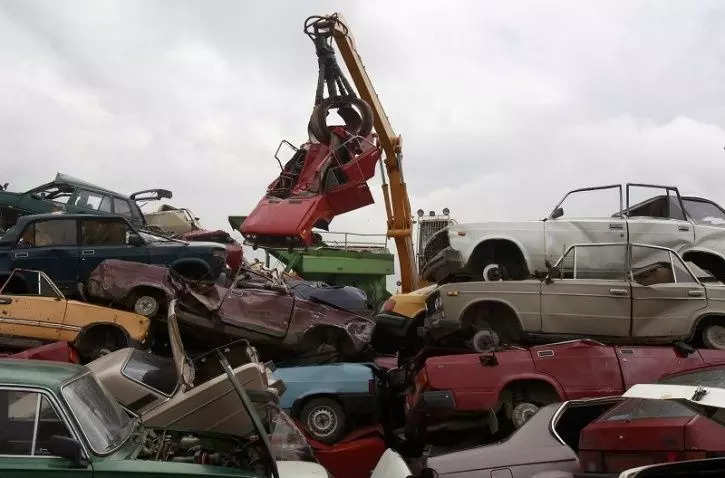
You can call it a car cemetery. On sprawling three acres of prime land in Uttar Pradesh’s Noida, over a hundred dilapidated vehicles are being arranged in stacks before each one is hauled for a 200-minute last journey. Unlike the birth of a car – from welding to painting – which takes 18-35 hours, depending upon the model, the last rites are much shorter.
The first port of entry is where the car’s tyres are removed. Then come various stations for pre-treatment – to segregate oils and remove airbags, batteries, plastics, glasses et al, with each item getting dispatched for recycling. Precious metals such as platinum, rhodium, and palladium – contained in the car’s catalytic converter – are also recovered. The remaining steel shell of the car is then compressed into a bale with a monster crusher before being transported to a steel mill for reuse.
Earlier this week, ET was present during the final journey of a few cars – a white Alto, a red Hyundai Santro and a couple of Omnis – at the Noida facility of Maruti Suzuki Toyotsu India (MSTI), a joint venture between Maruti Suzuki and a Toyota Group company.
The government has so far approved 72 such registered vehicle scrapping facilities, or RVSFs, across 16 states and Union Territories. Of these, 34 are in Uttar Pradesh alone, six in Haryana and five each in Gujarat, Bihar and Madhya Pradesh. Only 38 of the facilities are currently operational though.
With leading car manufacturers now investing big in scrappage facilities, the business of vehicle funerals may soon emerge as a critical component of India’s automotive industry.
Maruti Suzuki, Tata Motors and Mahindra and Mahindra, the country’s top three passenger vehicle OEMs (original equipment manufacturers) contributing about 65% of domestic sales annually, have set up scrapping facilities at multiple locations. More are in the pipeline.
“The government’s scrappage policy gives a clear business opportunity for auto OEMs,” Maruti Suzuki chairman RC Bhargava tells ET, adding that the backlog of old cars aged over 20 years, which he estimates to be about 5 million, needs to be scrapped with urgency. “Our industry has created a lot of junk over the years,” he quips.
The voluntary vehicle-fleet modernisation programme, popularly called vehicle scrapping policy, was unveiled two years ago, with the rules coming into effect from September 25, 2021. Car manufacturers have been on board from Day 1. After all, getting rid of old vehicles would mean a surge in demand for newer ones, leading to a spike in sales.
There is also an add-on. As older cars get scrapped, demand for used cars, especially for 7-9-year-old vehicles in tier-2 cities and rural markets, is likely to go up significantly, says Ashutosh Pandey, CEO of Mahindra First Choice Wheels. “At the moment, used cars of this age form a small part of overall sales by organised players. We expect this share to grow as demand increases, which in turn may firm up prices by 2-3%,” he says. Additionally, the most significant impact of scrappage will be on commercial vehicles, where a large number of older vehicles are likely to be scrapped, leading to likely spurt in demand for used commercial vehicles and formalisation of this unorganised market, he adds.
The 2022-23 annual report of the Ministry of Road Transport and Highways (MoRTH) has explained the main objectives of the scrappage policy in the following way – i) to shift to safer vehicles for citizens, ii) to boost automobile manufacturing and scrapping industries, iii) to ensure road safety by having newer vehicles, iv) to make cheaper raw materials including rare-earth metals available for industry, v) to help in reduction of oil import bill and pollution, and vi) to generate employment, boost investment and contribute to the growth of India’s gross domestic product.
According to a former MoRTH official, who was involved in the groundwork before rolling out the policy, the concept paper was originally designed with layers of incentives to customers who would be willing to get rid of their unfit and polluting vehicles. “The original idea was that if someone scraps a car, she should receive a 10% GST (goods and services tax) concession on buying a new car. We had a series of discussions with the ministry of finance on this, but it did not yield any result,” he says, requesting anonymity.
There is no doubt that the ministry of finance was a hands-on shareholder during the ideation of the policy. No wonder, the policy was first announced by finance minister Nirmala Sitharaman during her budget speech in February 2021 when she said how a voluntary vehicle scrapping policy “will help in encouraging fuel-efficient, environment-friendly vehicles, thereby reducing vehicular pollution and oil import bill.” She also added that vehicles would undergo fitness tests in automated fitness centres after 20 years in case of personal vehicles, and after 15 years for commercial vehicles. Such a mandatory fitness test is to start from October 1, 2024, and vehicles deemed unfit would be scrapped.
According to Motor Vehicle Act 1988, Certificate of Registration (RC), a mandatory document to run vehicles on public roads, needs to be renewed after 15 years. Whereas RCs are still getting renewed in most parts of India, an order issued by the National Green Tribunal in 2015 (which was upheld by the Supreme Court in 2018) banned all diesel vehicles aged over 10 years and petrol ones of over 15 years in the National Capital Region (NCR), a large geography that includes cities such as Delhi, Faridabad, Ghaziabad, Gurgaon, Noida and Meerut.
In the last couple of years, the Delhi government has swung into action with violators on the road getting increasingly impounded. “If any 10-year-old deregistered diesel vehicle and 15-year-old petrol vehicle is found plying on road on or after 01.01.2022, it shall be impounded and sent to the scrapyard,” a Delhi gover nment circular dated December 29, 2021 said.
What is more, the MoRTH also issued a notification earlier this year, saying that RCs for all government-owned vehicles won’t be renewed after 15 years, a step that may lead to the towing of some 900,000 vehicles to scrapyards.
In this backdrop, it’s only natural that more and more scrapping facilities will crop up across India and more so around Delhi. Setting up a scrapping facility with a yearly capacity of handling 10,000 vehicles requires a capital expenditure of INR 15-20 crore, clearly not a very big amount for car companies to spare. With the government policy in place now, established auto players are joining the scrapping bandwagon, also competing hard with unorganised players, for instance those in the grey markets of Delhi’s Mayapuri and UP’s Meerut, that have dominated this segment for decades.
A joint venture between Mahindra Accelo and government-owned MSTC, which operates under the brand name of Cero, meaning zero in Spanish with an allusion to zero carbon, has so far set up eight recycling facilities. More are coming up shortly. “Our average capacity is 15,000-20,000 vehicles per year per recycling facility. We have a plan to be present in 100 cities by 2025,” says Sumit Issar, managing director of Mahindra Accelo. Besides having its Noida facility, MSTI plans to add another centre in Gujarat by 2025, says its spokesperson.
Tata Motors, which has franchised scrapping facilities across India under brand name Re.Wi.Re, is also in an expansionary mode. The company at present owns three RVSFs with a combined capacity of disassembling 40,000 vehicles. “We intend to set up more,” says Girish Wagh, executive director of Tata Motors.
All these centres will however make money only when there is enough demand for scrapping, a n d when most customers owning near-dead cars find it more attractive to dispatch their vehicles to registered facilities rather than to a grey market. According to MoRTH’s estimate, India currently has about 10 million end-of-life vehicles eligible for scrapping. Various estimates suggest that scrap value is about 4-6% of the ex-showroom price of a new vehicle. “Unfortunately, maximum scrappage happens in the informal sector, so it is difficult to estimate the size of the industry,” says a Maruti Suzuki India official.
But a right blending of incentives and disincentives may change the dynamics soon. Under the government’s policy, vehicle owners are eligible for concession up to 25% of motor vehicle tax while buying a new car if the old car is scrapped in a registered facility and a certificate of deposit is obtained. This incentive policy is meant for dissuading customers to send cars to grey markets. So far, 15 states and UTs have announced such concessions, and according to data available with the MoRTH, as many as 9,898 such certificates were issued between January 1 and October 11, 2023.
Hemal Thakkar, a senior practice leader of Crisil, says a passenger car contains about 60-70% steel and 5-10% aluminium with the rest 20-25% being plastic, rubber, glass etc., which are also recyclable. Other materials such as lubricants, electronic components, batteries etc. are also recyclable, he adds.
Advanced economies such as the European Union, Japan and the US have mandated a high scrap recovery rate of about 85% over and above adhering to stringent disposal norms and human safety standards.
With expected expansion in the organised scrapping facilities across India, the compliance to the global standards is expected to improve, says Ravi Bhatia, president of Jato Dynamics, an automotive market research company.
But for organised players in India, an increased volume of unfit vehicles alone won’t be a good enough reason to rejoice. They have to find a more nuanced business strategy to take on grey market rivals. When ET posed as a customer and reached out to grey market car operators in Mayapuri and Mumbai’s Byculla, they insisted on one thing: “Bring your car. We want to inspect it first. We will pay you more if your tyres and other parts are in good condition.”
But a government-approved scrapper won’t ask for physical verification. The price will mainly depend upon the weight of the car models, e.g., about INR 17,000 for a Maruti 800 or INR 27,000 for an Alto.
“Black marketers disassemble the parts and sell the good ones separately. We don’t do that. We recycle everything according to global standards,” says a floor manager at the Maruti Suzuki Toyotsu India Noida facility.
A court ban or government’s disincentives may invariably help India’s total volume of unfit cars to grow exponentially. But that’s not enough. The government needs to reimagine its incentive bits of the policy to ensure that hundreds of dilapidated cars don’t land up in the alleys of Mayapuri or Meerut, creating a hazard for humans and the environment.
















